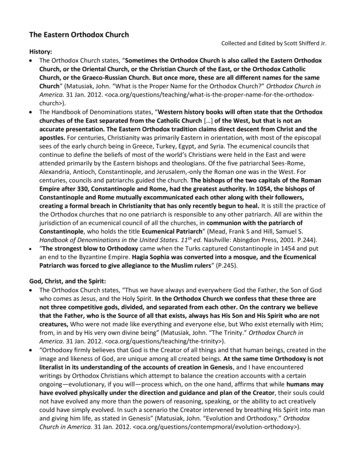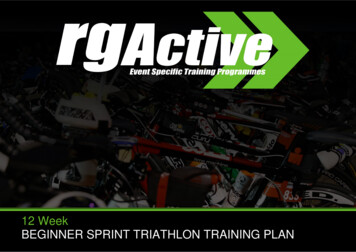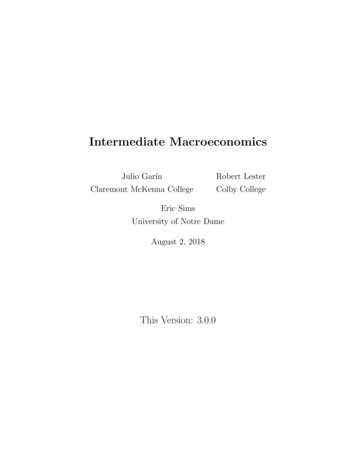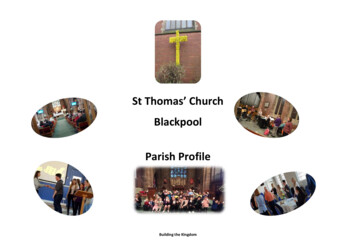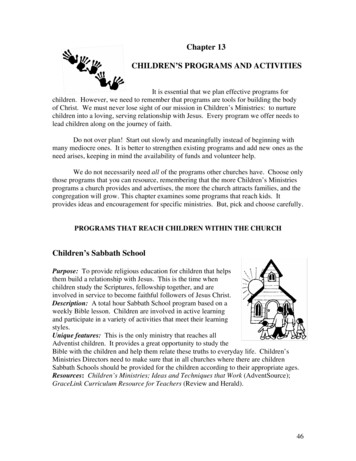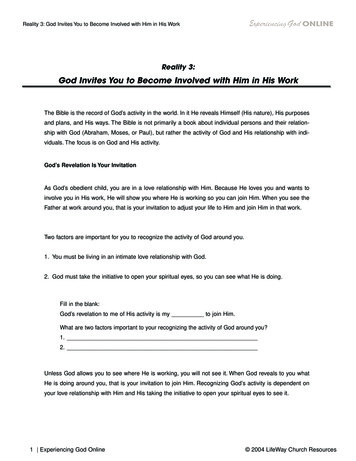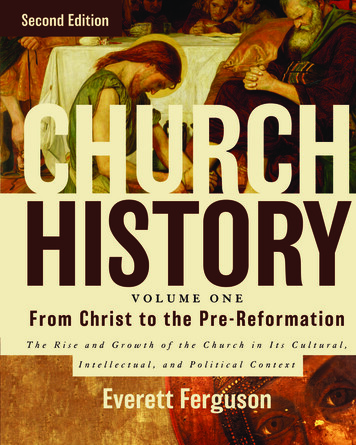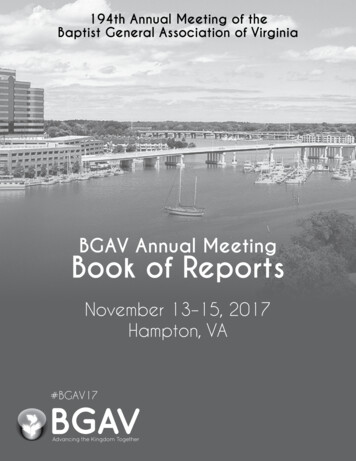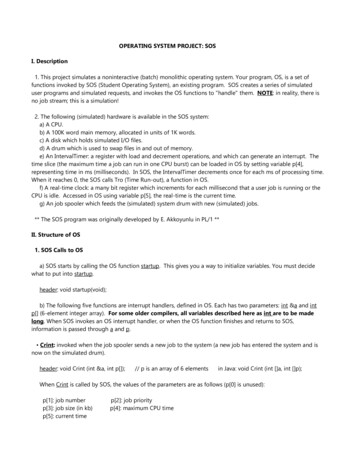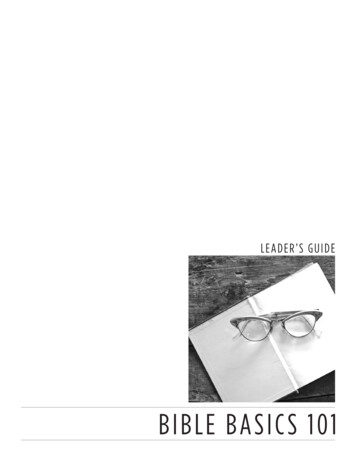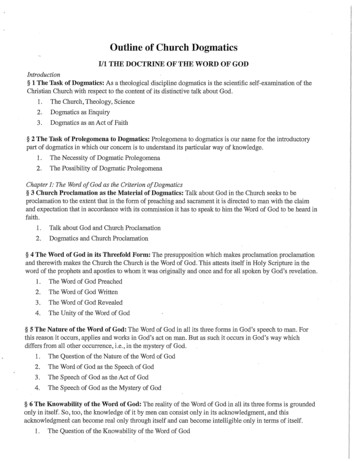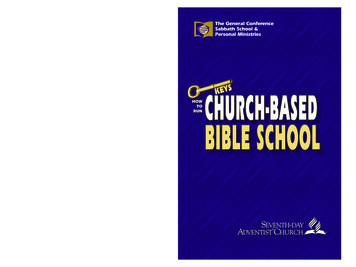
Transcription
How to Run:cover PRESS 4/20/10 2:33 PM Page 1Learn how to start your own church-based Bible school.This book provides step-by-step instructions to help you: Make friends in the communityConnect people with Jesus and help them become Hisdisciples Acquaint people with the Bible and the Seventh-dayAdventist message Show people how the Bible meets their daily needs Prepare your community for evangelistic meetings Help people take the step to become baptized churchmembers who make witnessing their way of lifeFor lots more Personal Ministries resources visitwww.sabbathschoolpersonalministries.org. This website has anextensive library of downloadable articles and activities toenhance the preparation of Personal Ministries leaders.PERSONAL MINISTRIES LEAFLETS How to Run a ChurchBased Bible SchoolThe MissionaryProgram for the LocalChurchMotivating Membersto WitnessGiving Personal BibleStudiesSmall Group MinistryPersonal WitnessingMethods of Door-toDoor VisitationGaining Decisions forChrist and His Truth The Work of thePersonal MinistriesLeaderReaching PeopleWhere They AreHealth EvangelismReclaiming theMissingSermon PreparationPublic EvangelismPrinciples of ChurchGrowthAdventist CommunityServicesPrison MinistriesISBN: 978-1-57756-580-29 781577 565802
How to Run a Church-based Bible School is created by the GeneralConference Sabbath School & Personal Ministries DepartmentEditor: May-Ellen ColonDesign: Linda McDonaldPrincipal Contributor: Calvin SmithAvailable from:AdventSource5040 Prescott AvenueLincoln, NE 68506800.328.0525www.adventsource.orgCopyright 2010 by the General Conference of Seventh-day AdventistsAll rights reserved. You may copy these materials for local church use.No part of this publication may be reproduced, stored in a retrievalsystem, or transmitted, in any form or by any means, electronic,mechanical, photocopying, recording, or otherwise for sale or distributionin any way outside of the local church leadership without the prior writtenpermission of the copyright holder.Printed in the United States of AmericaISBN: 978-1-57756-580-2
TABLEOFCONTENTSWhat Is a Church-based Bible school? . . . . . . . . . . . . . . . . . . . . . 5The Goals Are:. . . . . . . . . . . . . . . . . . . . . . . . . . . . . . . . . . . . . . . . 5What Methods Are Used? . . . . . . . . . . . . . . . . . . . . . . . . . . . . . . . 6How to Start a Church-based Bible school . . . . . . . . . . . . . . . . . . 6Some Tips on the Five Methods of the Bible school . . . . . . . . . . . 9Method #1: Personal Delivery . . . . . . . . . . . . . . . . . . . . . . . . . . . . 9Method #2: Correspondence . . . . . . . . . . . . . . . . . . . . . . . . . . . . 17Method #3: Small Groups . . . . . . . . . . . . . . . . . . . . . . . . . . . . . . 23Method #4: Video/DVD Ministry . . . . . . . . . . . . . . . . . . . . . . . . . 24Method #5: Internet (Local Church-based) . . . . . . . . . . . . . . . . . 2515 Ways to Enroll People in a Bible Course . . . . . . . . . . . . . . . . 254 Steps for Getting Decisions . . . . . . . . . . . . . . . . . . . . . . . . . . . 27Calling for a Decision toAccept Jesus as Savior and Lord . . . . . . . . . . . . . . . . . . . . . . . . 27Calling for a Decision to Keep the Sabbath. . . . . . . . . . . . . . . . . 28Calling for a Decision to Be Baptized . . . . . . . . . . . . . . . . . . . . . 29Appendix A - Discover Bible School Participation Form . . . . . . . . 31Appendix B - Welcome Letter . . . . . . . . . . . . . . . . . . . . . . . . . . . 32Appendix C - Reminder Letter . . . . . . . . . . . . . . . . . . . . . . . . . . . 33Appendix D - Student Record Sheet . . . . . . . . . . . . . . . . . . . . . . 343
4
HOWTORUN A CHURCH-BASEDBIBLE SCHOOLWhat Is a Church-based Bible School?A church-based Bible school is a versatile organizationoperated by a group of members in a local church who havea vision to reach out and provide an opportunity for people tostudy the Bible. They organize themselves into what hasmost often been called a “Discover” Bible school, which is abranch of, and works in partnership with, the Voice ofProphecy Headquarters School, and other Bible schoolsworld-wide.Whatever name is chosen for the Bible school, its aimshould be to provide a variety of flexible options andapproaches that will reach as many people as possible. Itshould be designed to include a local church’s entire Biblestudy outreach to its community and should utilize anyavailable outreach materials that the church decides to use.These may include a variety of Bible study guides, DVDs,and videos from Seventh-day Adventist print, radio, and TVministries.The Goals Are:1. To help make friends in the community.2. To connect people with Jesus and help them becomeHis disciples.3. To acquaint people with an in-depth understanding ofthe Bible and the Seventh-day Adventist message.4. To show people how the Bible meets their dailyneeds.5. To prepare a community for evangelistic reapingmeetings.5
6. To help people become baptized church memberswho make witnessing their way of life.What Methods Are Used?There are at least five ways local church members canstudy the Bible with the people in their community:1. Personal delivery of Bible lessons to individuals.2. Operating a Bible correspondence school in the localchurch.3. Small group Bible studies.4. DVD or video ministry to individuals or small groups.5. Operating an Internet Bible school on the localchurch’s computer or on a member’s personalcomputer.Before expanding on these five methods, here aresuggestions for starting any church-based Bible schoolwhich may include one or more of the above methods.How to Start a Church-based Bible SchoolFollow These Steps:1. Seek the Lord earnestly in prayer.2. Study this pamphlet carefully and tentatively list theneeded personnel.3. Prepare a Participation Form that includes thevarious activities and positions needed to operate theschool. (A sample is included at the end of thispamphlet).4. Preach a dynamic, spirit-filled, Christ-centeredsermon on witnessing which includes:a An introduction to the church-based Bibleschool concept, utilizing any available promotional video or DVD. (See Resources.)b. Experiences by individuals who have re6
c.sponded to personal Bible studies or Biblestudy materials.An appeal for helpers. Distribute the Participation Form, pray together, go through it together,and collect responses. Collect the forms beforedismissal. (It will show what people are most interested in and will provide a list of individualsfrom whom needed personnel can be selected.)5. Meet with the church board. (Successful schoolshave found it critical to have the full support of thepastor and the church board. This support is moresure after the sermon and the congregation’sresponse.)a. Discuss the concept and the congregation’sresponse to the participation form.b. Vote to organize the school as the umbrella organization of the full Bible study outreach ofthe church.c. Select and vote a name for the Bible school.d. Select a supervisor and an associate supervisor for the school. Each should be a personwith a strong desire to do outreach: one with organizational skills, capable oftraining others, and one who can coordinate well with thepastor and other leaders.e. Decide on a room or other area for the schoolthat provides space for individual lessons tobe organized and readily available, a filingcabinet as well as work space, etc.6. Obtain a Post Office Box for the Bible school namechosen by the church board. (Never use the churchstreet address.)7. Prepare and get church board approval of the Bibleschool budget.7
8. Order lessons and other needed materials.9. Register the school and, if possible, local zip codes,with the existing local conference/ mission Bibleschool so that interest names can receive immediatefollow up. (Voice of Prophecy headquarters schoolsoften have on record the postal zip codes which alllocal schools have agreed to service. Theyimmediately send to the local schools all intereststhey receive from those areas.)10. Select and train the team to operate the school.Depending on the size of the church, this wouldinclude: The supervisor and associate, mentionedabove. A leader for each of the five methods—mentioned above with details tofollow—decided upon for this Bible school Prayer ministry coordinator Interest coordinator Visitation coordinator Bible school promotion leader Individuals to assist with grading, recordkeeping, supplies, etc. Missionary leaders from Sabbath SchoolAction Units (The goal should be to involve asmany as possible. In small churches somemay care for more than one activity.)11. Prepare an interest list. Call and obtain names ofBible study and program interests from all Adventistradio and television and publishing organizationsincluding Literature Evangelist paid-out accounts andmissionary and health magazine interests. TheInterest Coordinator can combine these with thechurch interest list for the use of the Bible school.8
12. Establish a prayer ministry if your local church doesnot already have one.13. Involve and train members in how to find people whoare willing to study the Bible. (See 15 methodsbelow.)14. Share appropriate experiences every week inSabbath School, during the worship service, innewsletters, etc, to inspire others to participate.15. Set up a Sabbath lesson distribution center withcubicles of lessons in a visible location like the lobbyof the church.16. Provide lessons to the Sabbath School Action Unitsor classes.17. Utilize the assistance that is available from your localpastor, conference/mission leadership, and, ifpossible from the Voice of Prophecy via newsletters,telephone consultation, seminars, rallies, etc.18. Be sure to operate the Bible school in advance of,during, and after all reaping meetings.19. Plan on making the church-based Bible school apermanent soul winning means until Jesus comes.Some Tips on the Five Methods ofthe Bible SchoolMethod #1: Personal Delivery“This house-to-house labor, searching for souls,hunting for the lost sheep, is the most essential workthat can be done.”1This method has stood the test of time. And as anexperienced church member recently said, “Door to door9
work has never been better.” This is where you receive themost interesting experiences and greatest blessings andresults. It is also true that you will learn to face rejection. Butremember, you are there to find those with whom the HolySpirit is working. If you spend much of your time with theuninterested it is like picking fruit that is too green to eat.The best way to do it is to do it. One learns to swim in thewater, not by sitting in a classroom.General Visitation Principles:1. Dress appropriately.2. Depend on the Lord. Prepare with prayer, and praybefore, during, and after the visit.3. Make friends. Build bridges, not walls.4. Always know the objective of the visit. At the first visitto begin Bible studies with a person, the objectivewould be:a. to be brief,b. begin to establish a friendship,c. get the person to receive and study the lessons,d. gain the right to return,e. not to argue about anything.5. Know basically what you are going to say6. There are three things people want to know whenone comes to the door:a. Who is it?b. What do they want?c. How long are they going to stay? (You can answer those questions in less than a minute atthe door with the following canvass. When yousay, “We can’t stay long,” it disarms them andputs them at ease).Here is a Voice of Prophecy Discover canvass to be used10
door-to-door to introduce guide #1, or for following up a Biblestudy request card and other follow-up, as will be discussedlater. This canvass can also be adapted to fit whatever studyguides are being used. Note: It is best to call them “studyguides” and not “lessons.”Discover Door to Door Canvass:When someone responds to friendly 4 or 5 business-likeknocks, smile and say:“It’s great to find you home today. I am and this is. We are volunteers associated with The Voice ofProphecy radio broadcast. (Name your best-known mediaorganization.)(Hold the Discover guide before them in one hand andpoint toward it with the pen in the other hand.)“We can’t stay long, but we did want to give you your freecopy of the new Discover guide, which answers (open thecover and scan with the pen) life’s greatest questions.(Begin paging through.)“They are put together beautifully and each section issupported by Bible texts (point).“ and I enjoyed this so much we just wantedto share it with you.“When you finish reading these few pages there is asheet to help you review what you’ve read.“We want to leave this with you today and we will be backin the area about this time next week. “And if you enjoy it,(this relieves pressure and gives them an out) we’ll leaveyou another one.“Are you usually home about this time? Great!“Be sure to read it and fill out the answer sheet, and we’ll11
leave you another one next week. If you have any questionswe can discuss them. We’ll look forward to seeing you nextweek at (time) .”Types of VisitsHere are very brief suggestions for using the abovecanvass in various types of visits:1. Door To Door: As noted above, be friendly, brief, andpositive but give them an out.2. A Bible Study Request Card: Hold up the card andsay, “We came in answer to your request.” Try to geta personal study started.3. Friends, Family, Work Associates, and Neighbors:“I enjoyed this, so thought of sharing it with you. Iwould like your opinion of it.”4. Media and Publications: Take the print-out and say,“I see that you requested (name of material/s sent), and we wondered how you enjoyed it/them. Haveyou taken advantage of the new Discover guides?”5. Literature Evangelist Paid-Out Accounts: Take theprint-out and say, “I see that you bought (name thebook/s). Have you enjoyed it/them? Many peoplewho buy these books like to study the Bible itself. Youpaid for that. This is free.”6. Casual Visits: “Did you get your free copy of (namestudy guide) ?” or: “In view of (current tragicevent/s) , we have a gift for you that we found veryhelpful.”7. Community Services: “We wondered how you havebeen doing. We helped you physically. Now we’d liketo help you spiritually.”8. Missing Members: Consider why they are missing.Most often they are missing because of hurt feelings.12
They need friends and a fresh view of Jesus and Hismessage. It may take several visits to reestablishfriendship. Listen, love, care, apologize in behalf ofthe church, and never argue. Offer study guideswhen they indicate their interest and need.What to Do on the Return Visit/s:Briefly, in all personal delivery, prayer and friendship isthe key to success. Try to return weekly for a personalreview of the guides. Depending on the degree of interestand the time the student has, this may range from an indepth study where the teacher asks each question and thestudent reads his/her answer and most of the points arediscussed briefly, to only a brief scanning and marking of theguide, with, “You did a great job. Was it all clear? I’m happyyou agreed with the last question (the decision question).God bless you. Here are the next two study guides and I’llsee you next week at (time) .” Try to get a decision ateach visit.To expand on that, here are some helpful generalprinciples, followed by details on what to say when teachingthe Voice of Prophecy Discover guide #1. These could beadapted to fit other study guides as well.General Principles:1. Jesus is the center, focus, and essence of everylesson guide. Jesus must also be the center, focus,and essence of your life.2. Do what the guides do. They lead the student into aliving relationship with Jesus. Then they deepen itstep-by-step, gently, unobtrusively, introducing Hisloving will, stressing the blessings and privilege ofobeying Him. At an appropriate time, humbly tell ofblessings you have received.3. Prepare to get a total commitment to Jesus as Saviorand Lord in guide #6.13
4. Don’t argue. Once a student has committed himselfto Jesus and doctrinal arguments arise, Jesus is theanswer to every argument. Encourage the student tostudy further what God’s Word/Jesus says abouteach issue.5. To be in sync with the message of each guide, rereador scan it before each study and mark the answers inthe text. One can highlight them with a yellowmarking pen and write the page and paragraphnumber by the answer. Take this lesson guide alongwith you to the visit.6. Move at the student’s pace.a. Constantly listen and watch the eyes and bodylanguage.b. Don’t be boring. Make it quick and interesting.c. Build instructions and decisions on his/her understanding and comments.d. Stay on the student’s level. Say, “Let us seewhat we can learn together.”7. Ask what they enjoyed most. Ask if the topic is clearto them.8. Usually a review of the answer sheet can be thebasis of the brief discussion. First, glance at theresponse to the decision question and build youremphasis on it.9. Try to get a decision in every lesson, but don’t presstoo hard.a. Constantly build friendship.b. Keep the friendship and the study.10. To improve accuracy and interest, tactfully help thestudent find the right answers to incorrect ones, offerto change them, then mark the guide “100%.”14
11. To close the study, compliment the student on doingwell, and pray; if appropriate. Introduce the next twoguides, and say, “I’ll see you at (time) .”12. Depend constantly on the Holy Spirit and prayer.“While we are to labor earnestly for the salvation of the lost, we must also take time formeditation, for prayer, and for the study of theword of God. Only the work accomplished withmuch prayer, and sanctified by the merit ofChrist, will in the end prove to have been efficient for good.”2“The Lord imparts a fitness for the work toevery man and woman who will co-operatewith divine power. All the requisite talent,courage, perseverance, faith, and tact willcome as they put the armor on.”313. Expect success and you will have it.“If the teachers of His Word are willing, theLord will lead them into close relation with thepeople. He will guide them into the homes ofthose who need and desire the truth, bringingthem into the situations best suited to their talents.”4“When church members put forth earnest efforts to advance the message, they will live inthe joy of the Lord and will meet with success.Triumph always follows decided effort.”5Here is a suggestion for visiting and reviewing Discoverguide #1 that could be adapted to other guides as well.Always consider the conditions and the interest level.(Discover has these outlines for all 26 study guides.)15
The Visit to Review Guide #1:Objective: To be brief; gain the right to return; begin a friendship; andincrease faith in God.1. “We can’t stay long, but I was wondering how youenjoyed the first Discover guide?2. “Was there a particular point that you enjoyed themost?”a. It is better to encourage and let the person express satisfaction with the lesson than to talkyourself.b. If the person hesitates, you may say something like:c. “Isn’t it thrilling to know we didn’t just happen?”d. “I liked the idea that God has a personal relationship with people.”3. Ask, “Was the answer sheet helpful in reviewing whatyou read?”a. “Do you have it handy?”b. “Perhaps we can compare our answers?”(Don’t force.)4. Review it briefly, saying: “Excellent” or “Great” afterthe answers.Note: If you sense that the person is deeplyinterested, you could suggest that you will read thequestion and ask the person to share his/her answersand then discuss them briefly. Usually this practicewould come later than guide #1.5. If there is a wrong answer, tactfully help the studentfind the right answer and correct it, and then youmark it 100%.a. One could say, “My answer seems to be a littledifferent on this one. Let’s see. (Turn to themarked answer in your own lesson guide.)16
b.“Did you notice what it says here? Is that clear?Would you like to change that one? Great!”6. If the “Thought [decision] Question” is answered with,“Yes,” say,a. “I’m happy this study guide helped you to.”b. If the thought question is not answered, askthe question again, but don’t pressure thestudent.7. To close, thank the person for the time,a. Introduce guides #2 and #3 and say,b. “I’m looking forward to seeing you again nextweek at o’clock.”c. “Have a great week!”At times, some, even those who have sent in a requestcard will want to continue by correspondence or the Internet.We will now discuss the second method of the Bible school,correspondence:Method #2: CorrespondenceOperating a Bible school by mail is a simple procedureonce you have personnel, a P. O. Box (never use a streetaddress), a place to work, and materials in hand.Basic Needs:Supplies:1. Bible lessons and enrollment cards. (Order manymore of the first few lessons.)2. Window mailing envelopes with the Bible schoolreturn address for sending lessons to the students.3. Return envelopes with the Bible school address forthe students to use in returning their answer sheets.4. Postage stamps.5. Student record forms or a computer record system.17
6. Rubber stamp with your Bible school address on it.7. Labels on which to put the student’s name andaddress.8. Labels with the Bible school address on them.(Unless you have envelopes and lessons printed, oruse the rubber stamp on envelopes and lessons, youwill need three of these labels every time you sendout a lesson.)Equipment Needs:1. A computer and printer, or a typewriter.2. A three-ring letter-size notebook with an alphabeticalseparator to file the student record sheets.3. A postal scale.4. Work tables for those correcting answer sheets, andfor those filling envelopes and other activities.5. Access to a duplicating machine.6. A pigeonhole setup for each of the individual guidesand answer sheets.Procedures:When a request for Bible lessons is received, enter thename in the record system. (A sample student record form isincluded in Appendix D.)Type three labels of the student’s name and address: onefor answer sheet #1; one for answer sheet #2; and the thirdone for future use, such as reminder letters and invitations toevangelistic meetings or other events.Place the following items in a window mailing envelope(with the Bible school return address on it):1. A welcome letter from the Bible school. (See thesample in Appendix B.)18
2. Bible guide #1 and answer sheet #1 with the addressof the school on it. Affix the student’s name andaddress label to the answer sheet so that it will showthrough the window of the envelope.3. A return envelope with the school address on it forthe student to use to return the answer sheet forgrading.Pray for the student before mailing each guide andanswer sheet.Pray daily for the student.What to Do When the Student Does Not Respond:After 14 days with no response, automatically mail guideand answer sheet #2 with a reminder letter (see suggestedreminder letter in Appendix C) and a return envelope with apostage stamp on it. People don’t like wasting a stamp and itis an incentive to mail the answer sheet back.If there is no response, in another 2 weeks mail anotherreminder letter, or make a telephone call or a visit asdescribed below. The visit usually works best!In visiting those who have not responded to Guide #1that was mailed, there are several considerations. Thefollowing can be adapted for use with other lessons and forboth correspondence and personal Bible studies.Preparation:To save much time, especially with large numbers ofinterests, color code on a map various types of names youplan to visit. For example: You may choose to put missingmembers in one color, cooking school interests in anothercolor, or age groups in various colors. You may want toseparate Bible study, evangelistic meeting, and mediainterests into separate colors, etc.Have several copies of guide #1 as you will haveoccasion to enroll new people.Pray before, during, and after the visit.19
Suggested approach to a student who has read theguide but has not done the answer sheet:(Most people just need a little encouragement to getstarted with something new and unfamiliar).“Good (evening). Are you ? It is good to find youhome . I am and this is . Werepresent the Bible School (Hold up Guide#1).We can’t stay long, but we were wondering if youreceived the guide you ordered?”If the answer is “Yes,” say, “Hundreds are thoroughlyenjoying this free series. We’ve enjoyed it very muchourselves.“You certainly made a wise choice in ordering it.“Were you able to read the first one yet?(If read but not filled out, say): “I understand, it is abusy life, but, you know, I actually found it very easyto do.“Could you bring your guide and let’s review a few ofthe answers together?” (If they don’t have the guide,use a new one.)Turn to the answer sheet and say, “Notice the firstquestion asks . What would you say, afterreading the guide, that the answer to that would be?”When the answer is given, you ask the nextone, get a response, and then hand the guideand pen to the student and say, “Now you areon your way. It is really easy isn’t it. Why don’tyou answer the others? (or “Would like to finish it?”)Let the student complete it with very little assistance. This will give him confidence. Discuss it briefly and say,20
“I am going to leave you guide #2. I know you canhave it done and sent off in a couple days.“When your answer sheets are received, theywill be graded and your questions will be answered.Your corrected answer sheets along with lessons#3 and #4 will be sent to you.You’ll be finished before you know it and receive adiploma, but more than that, your Bible knowledge will be greatly increased.”Pull out an envelope and reach for your stamps andsay, “To make it a little easier I’ll put the stamp on theenvelope for you.”Suggested approach to a student who has not read theguide:When you discover the guide has not been read, say,“I understand. It is a busy life but you know, I actuallyfound the guide very easy to do.“It is made for busy people like you.“It will take you only a few minutes to read it, fill outthe answers, and mail it.“I have confidence that it won’t take you long, so I amgoing to give you guide #2.“If you prefer, I would be happy to stop by next weekabout this time and leave you the next two guides.“If you have any questions, we can discuss thembriefly.” (If they choose by mail, apply a stamp to theenvelope.)Try to start a personal Bible study:If the interest is very good and if your schedule allowsyou to deliver and grade the lessons in the home, say:21
“I plan to be in the area next week about this timeand would be happy to review guide #2 with you andleave you guide 3 and 4. It was fun studying togethertoday.” Arrange the time.Offer videos, DVDs, participation in a small group orthe internet if the student is not interested incorrespondence or personal study in the home.Success Secrets:1. Make prayer a vital part of grading.2. Never give a grade less than “Good.”3. Forming a relationship is essential.4. Handwritten notes of encouragement such as: “Youare doing a great job,” and/or “Keep up the goodwork” help the student to feel that his/her instructor isa friend.5. If a question is asked that will be answered in a futurelesson, tell them that, rather than trying to answer itnow. This gives them an incentive to continuestudying.6. Be careful not to be too positive in responding to astudent’s personal questions about his/hercircumstances. You are usually hearing only one sideof the story, and there is danger in leaping toconclusions.7. Let the students know you are praying for them. Askif they have prayer requests.8. Record all decisions and responses on the studentrecord sheet (such as the one in Appendix D), andmake the pertinent information available to othersfrom the Bible school who may visit the student.9. Return answer sheets immediately.22
10. Watch for indications of conviction and send anappropriate visitor immediately. Immediate follow-upis essential to success.11. If possible, correspondence students should receiveat least three personal visits from the sameappropriate visitor: After the appeal to accept Christ;after the Sabbath is presented; and after the studyguide makes an appeal for baptism. (Note decisionmethods below).12. If possible, enroll the student in personal studies or asmall group using the Bible course.13. Pray over the lessons when they are ready to bemailed and ask the Prayer Ministry Coordinator tohave the church members pray for the students.14. Always invite the student to take another Bible coursewhen they complete the current course.15. Do faithful follow-up.16. Conduct regular graduations and other special eventsfor the students at the church. A graduation at thebeginning of an evangelistic series is a good way toget students to attend.17. It is very advisable that a Bible school be conductedduring evangelistic meetings, followed by anothergraduation at the end of the series.18. Visitation, prayer, and perseverance are essential.And now we turn to the third method of the church-basedBible school.Method #3: Small GroupsA method from “One Who cannot err”6Remember that personal contact is the key to success.With this method students can review Bible guides and or23
Bible study videos/DVDs of your choice weekly with others ina warm relationship setting, or move Bible student graduatesinto a group of 3-12 as a transition to church membership.Basic Elements: Leadership: Leader and assistant who know how tofacilitate discussion and see that spiritual, social, andpersonal needs are met. Host/hostess in charge of hospitality. Group of 3-12 persons seated in a circle in adistraction-free location. 60 minutes:20 for sharing,40 for Bible study and prayer time.We turn now to the fourth method.Method #4: Video/DVD MinistryIn this TV age, ma
study the Bible with the people in their community: 1. Personal delivery of Bible lessons to individuals. 2. Operating a Bible correspondence school in the local church. 3. Small group Bible studies. 4. DVD or video ministry to individuals or small groups. 5. Operating an Internet Bible s
